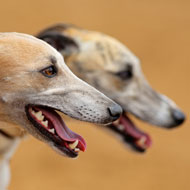'Elusive' species given captive breeding programme
The Royal Zoological Society of Scotland (RZSS) is helping to launch a conservation breeding and research programme for the Arabian sand cat.
Using its DNA expertise, the RZSS WildGenes conservation genetic library will provide vital information for the programme's design and implementation.
Al Ain Zoo, based in Abu Dhabi in the United Arab Emirates, has the largest known captive population of Arabian sand cats in the world, yet has little knowledge of the species.
Therefore, the RZSS WildGenes laboratory will use blood samples from the zoo's cats to extract their DNA and determine their genetic diversity, in order to help establish a captive breeding plan for Arabian sand cats.
The genetic tools it develops will also be used to monitor wild populations of the species.
"This is an important step in conserving the Arabian sand cat," said Dr Helen Senn, research scientist at the laboratory. "Atlhough the sand cat is classed as 'near threatened' as a whole, the threat to local populations can be much greater."
Muna al Dhaheri, acting chief of conservation and education at Al Ain Zoo, commented: "The DNA analysis project will help us to better understand this elusive species, which will serve as a major contribution to conservation efforts, while also establishing a foundation for potential reintroduction and long-term sustainability."
The Arabian sand cat, found deep in the deserts of Arabia, North Africa and Central Asia, is the only species of cat to inhabit true desert.
While listed as "near threatened" on the International Union for Conservation of Nature (IUCN) Red List, there have only been four reliable sightings of the species since 1995. The programme collaborators say it is difficult to estimate the true number of Arabian sand cats left living in the wild, due to their elusive nature.
Image courtesy of RZSS



 The Greyhound Board of Great Britain has published new vaccination guidance, with all greyhounds registered from 1 January, 2027 required to have the L4 leptospirosis vaccination, rather than L2.
The Greyhound Board of Great Britain has published new vaccination guidance, with all greyhounds registered from 1 January, 2027 required to have the L4 leptospirosis vaccination, rather than L2.